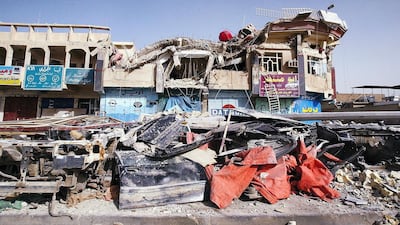In Sinan Antoon's The Baghdad Eucharist, which was translated into English in 2017, the fault lines within an Iraqi Christian family are mapped and the individual struggles and shared strength of two of its members charted. In Antoon's latest novel, The Book of Collateral Damage, the Iraqi author returns to the subject of the Second Gulf War and shows once again how ordinary lives are rocked, shaped or ruined by conflict.
But Antoon is too good a writer to simply retread old terrain. For this, his fourth novel, he explores new ground by depicting turmoil and carnage through a series of richly diverse second-hand sources. What's more, his protagonist is not someone caught up in the chaos but an exile trying to make sense of it from afar. It is an unconventional approach but the big risks Antoon takes enable him to perform mean feats.
The book’s main character is Nameer. Like his creator, he left Iraq for America after the First Gulf War and has pursued an academic career. It is 2003 and he interrupts his doctoral work to assist as translator for an American pair making a documentary about the mayhem and destruction brought about by the invasion and occupation of his homeland. Nameer accompanies them to Iraq, all the time questioning his decision to do so: “Had I come to rediscover something, or to make sure it was lost?”
While in Baghdad, he visits relatives and old haunts. He also takes a tour of Al Mutanabbi Street, where he encounters Wadood, a bookseller who has embarked on the project of a lifetime – to archive everything destroyed in the war. When they meet, Wadood has completed the first chapter, which comprises a history of the first minute of the conflict. Along with human casualties, he intends to catalogue "the losses that are never mentioned or seen" – from animals to plants to inanimate objects – "anything that can be destroyed".
Nameer shows an interest in this singular work and returns to the US with Wadood's manuscript. He tries to settle down into his new job at New York University but instead grows more and more fascinated by the bookseller's project. Soon that fascination turns into an obsession. The catalogue becomes "the frame of reference that overdetermined the way I perceived things" – but it also acts as a necessary, overdue prompt, galvanising Nameer into excavating his past and examining his state of mind.
The Book of Collateral Damage is no straightforward tale. Nameer's exploits are intercut with excerpts from Wadood's catalogue. One minute we are hearing about Nameer's date with a new flame, an argument with an old school friend, a session with his therapist or meeting with an anti-war group, while the next we are absorbed in Wadood's multiform writings – letters, memories, "fragments of poetry and musings". He also provides a range of beguiling meditations from an assortment of people and things, such as a bird, a caliph, a prisoner of war, a foetus, an oud, a tree and a horse.
Some of these "colloquies" are too whimsical, others are too opaque. But when they work, they prove extremely effective. A clay oven talks us through its life with its owner – "She feeds me so I feed her" – breaking off when bombs destroy their house and halting the reciprocal feeding. A wall complains about the burden of watching a grief-stricken mother pine for her disappeared son. This anecdote ends with a similar blow: the house is no longer a house "and I too am no longer a wall".
The narrative becomes intertextual when Nameer starts expanding Wadood's catalogue by adding his own recollections and "ramblings". It then becomes metatextual when Nameer is given inspiration for a novel from a newspaper article he reads about an Iraqi man who worked around the clock washing the dead (that practice is the subject of Antoon's second novel, The Corpse Washer).
After a while, The Book of Collateral Damage begins to resemble an elaborate and intricate patchwork of seamlessly stitched stories, ruminations and verses. Antoon's more fantastical elements put us in mind of the fictions of Argentinian writer Jorge Luis Borges. Not only is the novel prefaced by two epigraphs from Borges, but Wadood's "open-ended book" is redolent of the "indefinite and perhaps infinite" universe in Borges's short story The Library of Babel.
Those who shy away from such flights of fancy and prefer their fiction to be more grounded can lose themselves in Nameer's account of his trials and errors in both his personal and academic lives, together with his views on the situation in the country he left behind and his progress and observations within his adopted home land.
Jonathan Wright, who expertly translated Ahmed Saadawi's 2013 book Frankenstein in Baghdad, skilfully conveys Antoon's blend of reality and unreality. Formally daring, stylistically inventive, this is Antoon's most complex work to date. It challenges but it also impresses and enthrals.


